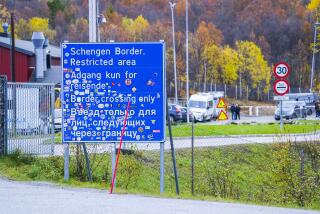For Norway’s Guardian of the Soviet Border, the Job Is a Far Cry From the Cold War
- Share via
KIRKENES, Norway — Every month Brigadier Inge Torhaug, Norway’s commissioner for its border with the Soviet Union, meets his Soviet counterpart for talks, and then they drink vodka, have a sauna or watch a film.
A small and dapper 60-year-old, Torhaug is the man who ensures that the 122.5-mile border along the far north of Norway remains a low-key exception in East-West border relations, far from the concrete and barbed wire of the Berlin Wall.
A scattering of wooden huts, a wire mesh fence, a few border posts and a padlocked gate near the mining town of Kirkenes are the only signs that a NATO member shares a border with the Soviet Union.
Daily Conversations
Torhaug, a former intelligence colonel, chats with his Soviet counterpart--Col. Alexander Ivanovich--on the telephone every day.
Once a month, the two men meet alternately on either side of the border to discuss official business through an interpreter. Then, switching to first-name terms, they relax with caviar and vodka, a film, snow-scooter races or a sauna.
“Pink Panther films are popular, so are westerns,” Torhaug said. “After a hard day’s eating and drinking, we march as best we can past the guard of honor and thank each other.”
Since World War II not a shot has been fired in anger on this border, which winds through Norway’s Finnmark region high in the Arctic circle.
Cordial Border Relations
Dramatic attempts to escape to the West by Soviet citizens are virtually unknown and the only territorial violations are committed by herds of Norwegian reindeer.
Blissfully unaware of ideological differences, they wander across the frozen Pasvik river, which marks the border.
In winter, temperatures drop as low as minus 49 Fahrenheit. Finnmark is sparsely populated and inhospitable, and the Soviet Union long ago removed any inhabitants from near its border.
Norway, keen to keep tension low on the alliance’s northern flank, does not allow NATO exercises and keeps only about 150 border guards.
But Torhaug says that the relaxed and cordial border relations play a vital role.
‘Fear Us Just as Much’
“Of course, our dealings wouldn’t stop a war. But we have to understand each other--we have to understand what we fear about the Russians.”
“They fear us just as much. You have to remember that the Germans attacked the Soviet Union from here in 1941 after they occupied Norway--and the Soviets remember that.”
What kind of a man is Alexander Ivanovich?
“An enigma in many ways,” Torhaug said. “He’s about my age and he doesn’t really understand the new Soviet openness, glasnost . He grew up in an age when things were different.”
The two men share a love of music, art and literature and often discuss these topics and their families.
Undramatic Meetings
“We don’t really talk much about politics and defense matters,” Torhaug said.
The formal business at meetings, conducted at a table on which stand small Norwegian and Soviet flags, is as undramatic as the border.
The daylong meetings, provided for under a 1949 border agreement, revolve around how best to herd back the errant Norwegian reindeer, or whether the border posts need repairing after the ravages of winter.
Torhaug’s border station, called Skorskog, is a small wooden building where the discussions take place every other month. Ivanovich plays host in a building of his own, just a few hundred yards beyond the border fence.
More to Read
Sign up for Essential California
The most important California stories and recommendations in your inbox every morning.
You may occasionally receive promotional content from the Los Angeles Times.













